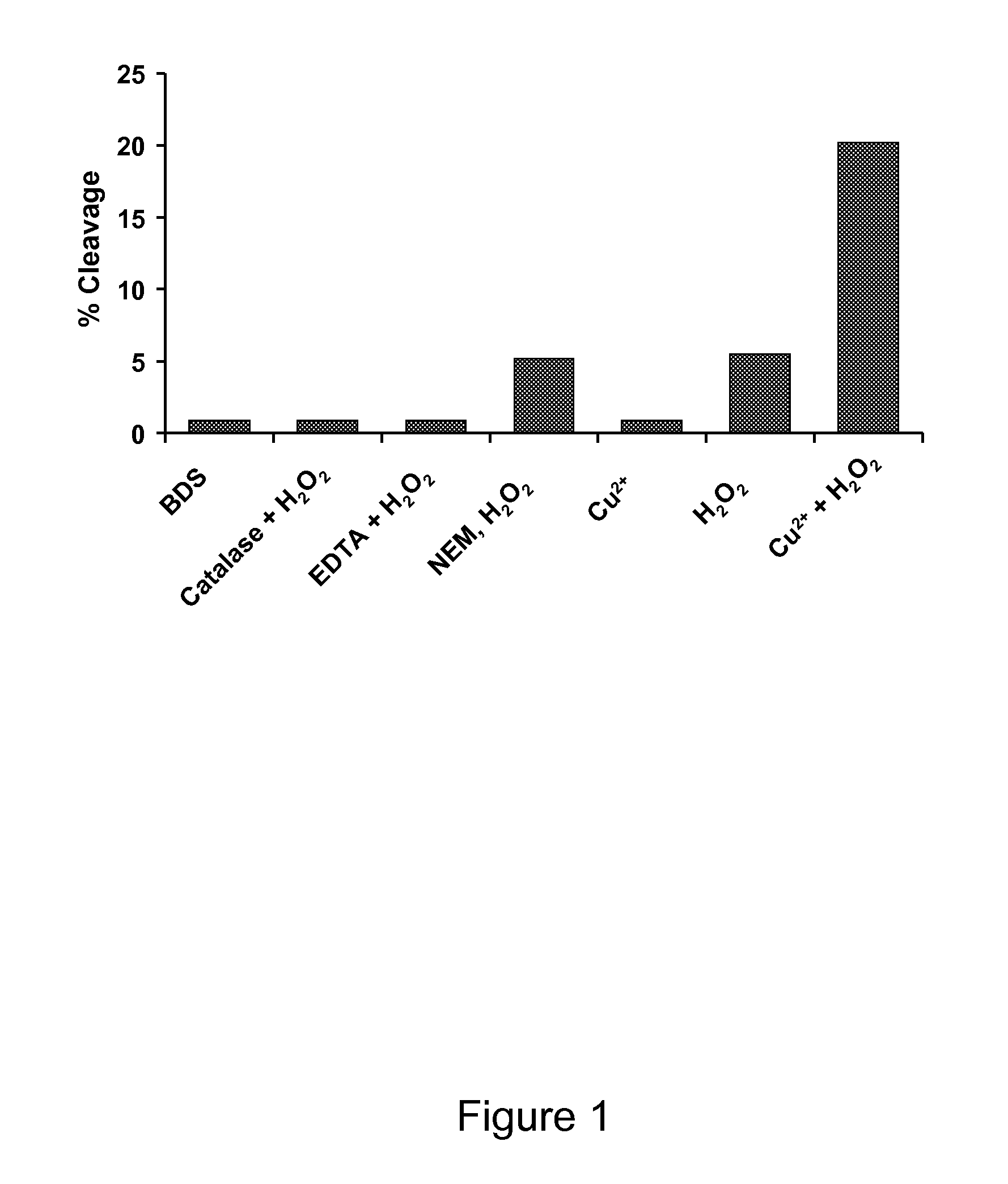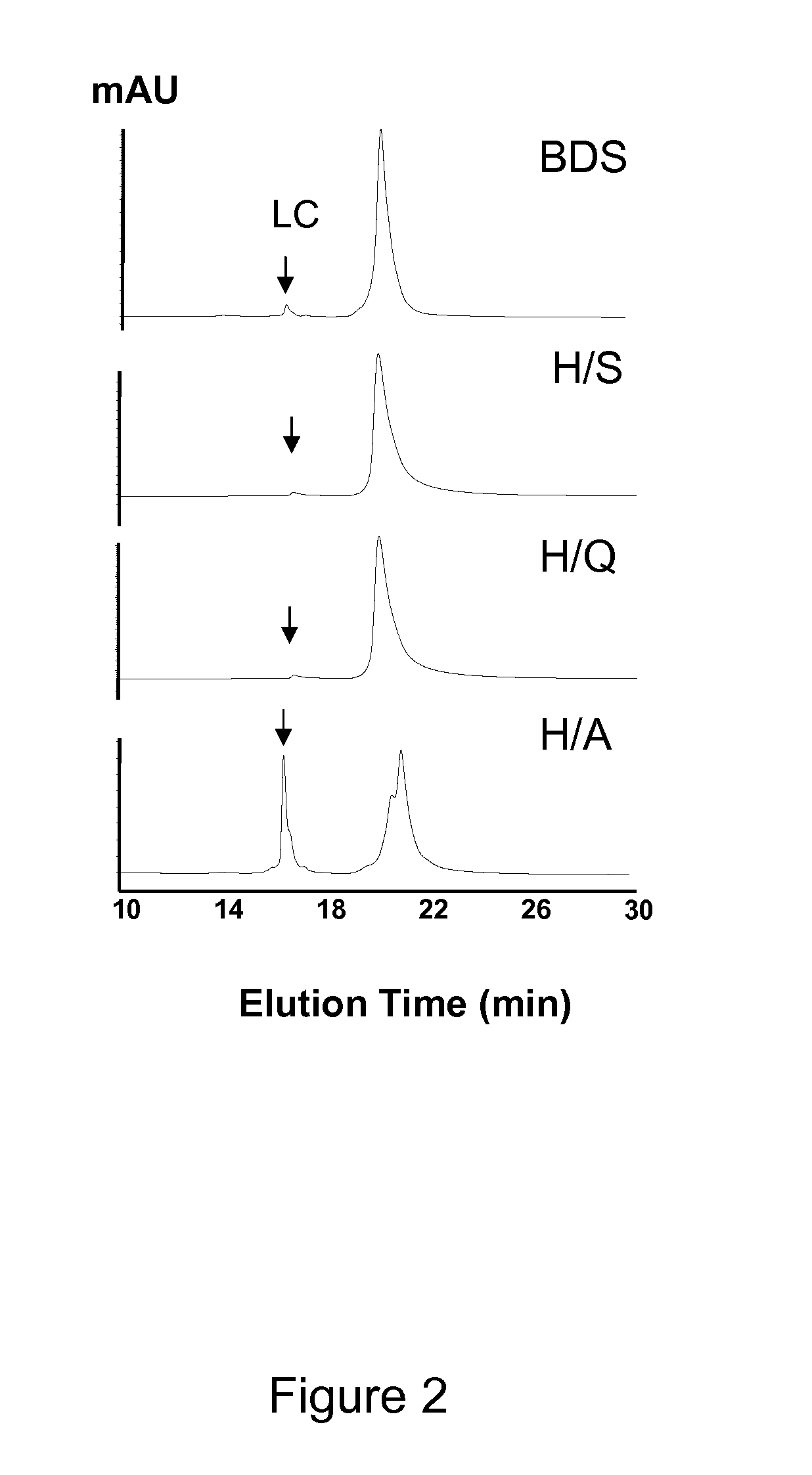FRAGMENTATION RESISTANT IgG1 Fc-CONJUGATES
a technology of igg1 and conjugates, which is applied in the field of immunoglobulins, can solve the problems of reducing the manufacturing yield of therapeutic and diagnostic products, reducing the efficacy of peptide bond cleavage, and reducing the disulfide bond cleavage. , to achieve the effect of reducing fragmentation events and reducing disulfide bond cleavag
- Summary
- Abstract
- Description
- Claims
- Application Information
AI Technical Summary
Benefits of technology
Problems solved by technology
Method used
Image
Examples
example 1
[0049]This example describes the results of a specific hinge fragmentation of a human IgG1 antibody by H2O2-mediated radical cleavage that led to the loss of one Fab domain and the formation of a partial molecule. H2O2 attack of the IgG1 resulted in the breakage of the inter-chain disulfide bond between the two cysteine residues located at position 226 (Cys226) in the hinge region and followed by the formation of sulfenic acid (Cys226SOH) and a thiyl radical (Cys226S*), which initializes an electron transfer to upper hinge residues, leading to radical-mediated polypeptide backbone fragmentation.
[0050]The antibody used was a recombinant fully human antibody of the IgG1 subclass. The molecule was expressed in CHO cells and chromatographically purified using conventional techniques. The antibody fragments were separated by size exclusion chromatography (SEC). The cleavage of antibody was measured by a percentage of partial molecules (C1 and C2).
[0051]Briefly, a reaction mixture (1.0 mL...
example 2
[0060]This example summarizes the results of radical-mediated fragmentation of the IgG1 Fc.
1. IgG1 bulk antibody contains ˜1% of a truncated antibody (P1), which was determined to be a heavily oxidized form, with one of the Fab domains missing.
2. Reaction of H2O2 with IgG1 bulk drug substance (BDS) generated a truncated molecule and one free Fab domain fragment by specific cleavages in the hinge region which resulted in the formation of a C-terminal ladder of residues (Cys220-Asp221-Lys222-Thr223-His224-Thr225) in the Fab domain of the heavy chain (Fd) and a complementary N-terminal ladder of residues in the Fc domain.
3. In the H2O2 treated samples, for the majority of intact and truncated molecules the inter-chain disulfide bond between the Cys226 residues was found to be intact.
4. In the BDS sample, there was no unpaired disulfide bond in the hinge region observed by the native Lys-C peptide map that was performed after pre-blocking any potential unpaired Cys by N-etheylmaleimide ...
example 3
[0061]This example demonstrates that hydroxyl radicals and not Cu2+ induces hinge fragmentation. Hydrogen peroxides can regulate the biological function of proteins through radical induced oxidation pathways. Additionally, reaction with hydroxyl radicals can lead to various chemical reactions that result in the degradation of a protein. To examine if OH radicals are involved in the hinge fragmentation and to evaluate several factors that may influence the cleavage, the IgG1 was subjected to H2O2 attack. As shown in FIG. 1, the H2O2 induced fragmentation was completely blocked by catalase, indicating that OH radicals were responsible for the cleavage. Total free thiol groups were determined to be ˜0.28 mol / mol antibody under denatured conditions in the presence of 4 M GdnHCl using Ellman's reagent, 5,5′-dithiobis (2-nitrobenzoic acid) (DTNB). Prior to H2O2 treatment, the IgG1 was incubated with NEM at pH 5.0 for 3 hours at 37° C. The NEM blocked sample showed only a ˜7% decrease in c...
PUM
| Property | Measurement | Unit |
|---|---|---|
| pH | aaaaa | aaaaa |
| mass | aaaaa | aaaaa |
| mass | aaaaa | aaaaa |
Abstract
Description
Claims
Application Information
 Login to View More
Login to View More - R&D
- Intellectual Property
- Life Sciences
- Materials
- Tech Scout
- Unparalleled Data Quality
- Higher Quality Content
- 60% Fewer Hallucinations
Browse by: Latest US Patents, China's latest patents, Technical Efficacy Thesaurus, Application Domain, Technology Topic, Popular Technical Reports.
© 2025 PatSnap. All rights reserved.Legal|Privacy policy|Modern Slavery Act Transparency Statement|Sitemap|About US| Contact US: help@patsnap.com



